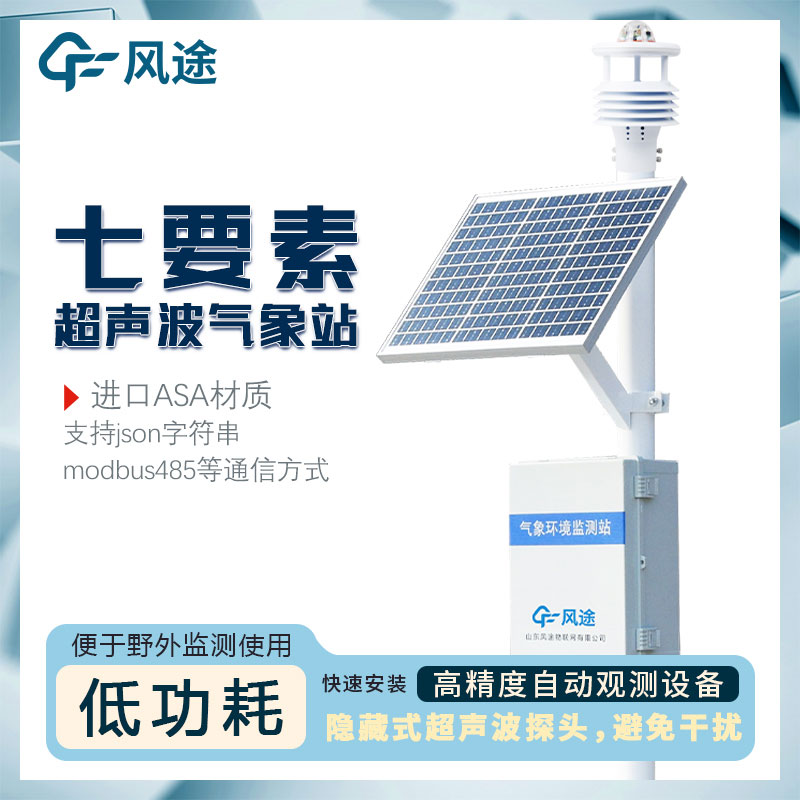Shandong Fengtu IOT Technology Co., Ltd
Sales Manager:Ms. Emily Wang
Cel,Whatsapp,Wechat:+86 15898932201
Email:info@fengtutec.com
Add:No. 155 Optoelectronic Industry Accelerator, Gaoxin District, Weifang, Shandong, China

Sales Manager:Ms. Emily Wang
Cel,Whatsapp,Wechat:+86 15898932201
Email:info@fengtutec.com
Add:No. 155 Optoelectronic Industry Accelerator, Gaoxin District, Weifang, Shandong, China
time:2023-04-13 09:02:35 source:Weather Station viewed:688 time
The integrated weather monitoring system, also known as weather station, provides timely warning of possible weather disasters by collecting, processing and analyzing weather elements in real time. It is mainly used in the field of agricultural production, emergency management of cities and industrial enterprises, disaster prevention and mitigation work, etc. With the increasing level of economic construction and urbanization in China, the country is investing more in infrastructure development to cope with the adverse effects of global climate change in the coming years, one of which is to strengthen the capacity of meteorological services.
Because traditional manual observation means cannot meet modern needs, the integrated weather monitoring system replaces human observation. The system reflects current technologies - Internet of Things, sensors, cloud platform, wireless transmission, etc. The weather data is collected in real time through sensors and then transmitted in real time through GPRS network, users can log in Web page, cell phone APP will be able to view the data, has achieved the purpose of remote supervision. This effectively improves the efficiency of meteorological observation work, and the site does not need to be manned, but only needs regular maintenance.
At the same time, because of the variety of weather services, a large number of weather observation products are needed to support all kinds of disaster forecasting and other related services. Therefore, the meteorological industry has become a new industry. There are already many regions in China where weather stations have been established, and these stations have started to provide services such as weather monitoring, disaster weather warnings and information dissemination.
As a new type of modern meteorological monitoring instrument, the integrated meteorological monitoring system has the following features:
1. automatic monitoring function: continuous operation around the clock, 24 hours a day, to ensure real-time monitoring data;
2. high degree of intelligence: various weather phenomenon parameters can be obtained and downloaded for viewing through computer terminals or mobile terminals;
3. High degree of automation: computer-controlled operation without human intervention, the whole process relies on the computer system to complete, greatly improving work efficiency;
4. Good stability: not subject to harsh environmental interference, long service life;
5. Low cost: easy installation and maintenance, low maintenance cost;
6. can be customized according to customer needs of a variety of weather station products.

With the intensification of global climate change, climate anomalies are frequent, and extreme weather events such as heavy rainfall and flooding occur from time to time, posing great challenges to the construction and development of cities and villages. Under such circumstances, the protection of t...
Wind speed and direction measuring devices were probably one of the first types of sensors to be developed in history. Since ancient times, knowing the speed and direction of the wind has been of great importance in many fields such as agriculture, navigation, and construction. This article will loo...
Soil moisture monitor is an instrument for measuring soil moisture and temperature, which is usually used in agriculture, forestry, geology and other fields. This instrument can automatically monitor the moisture content and temperature of the soil and transmit the data to a computer or mobile phone...
Intelligent online rainfall sensor is a kind of high-precision, real-time monitoring, automatic recording and remote transmission of rainfall data. It is mainly used for real-time monitoring of rainfall and analysis of rainwater collection, flow, intensity and other data, providing important data su...